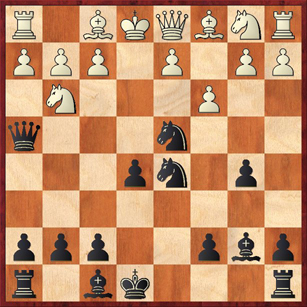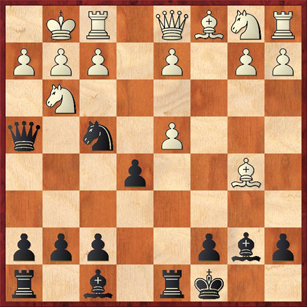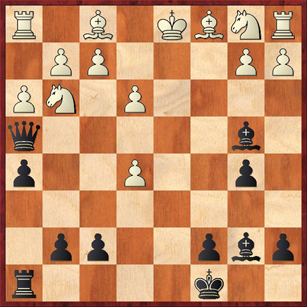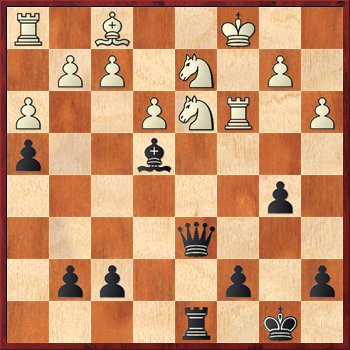Today I’m going to discuss a game that I already wrote about in Blogging from 32,000 Feet, but this time we’ll look at it from the viewpoint of my opponent! Tim Rogalski e-mailed me and said that he had written up some annotations for our game that he is going to submit to the Virginia Chess Federation newsletter at http://www.vachess.org. However, he thought it would also be cool if I put his notes on my blog, along with my comments on his notes. I think it will be cool, too! I really like it when both players comment on a hard-fought game. There was a good example of this recently on ChessLecture, where both Jesse Kraai and Bryan Smith commented on a game that they played in the World Open.
Also, it’s worth looking at this game again because a recent U.S. Chess League game featured the Fritz Variation of the Two Knights Defense, and perhaps this game puts Black on thinner ice than he was before. I’ll talk about that below.
So, let’s get started! Tim Rogalski’s annotations are in regular type, and my annotations are in italics. To download the PGN, go to my earlier post, Blogging from 32,000 Feet.
Note: Tim’s article also contains a great personal account of going to Tulsa with the Kaufman family — father Larry, who finished second in the Senior Open, and son Ray, who tied for first in the Master Invitational and also won $1800 playing poker at the casino! I thought about including this part of his article here as well, but finally decided not to — it would make the post too long, and besides, I’ve got to leave something for readers of the VCF newsletter to look forward to!
Rogalski, Timothy (1916) — Mackenzie, Dana NM (2090) [C57]
U.S. Senior Open 2009
1. e4 e5 2. Nf3 Nc6 3. Bc4 Nf6
The Two Knights Defense. I’ve been playing this since the 1970s, when I read an article on it by the late Paul Keres in Chess Life. Keres said that if there is any justice in chess, 1. … e5 should be a sound response to 1. e4, and 3. … Nf6 should be a sound response to 3. Bc4. I was willing to take Keres’ word for it! (DM)
4. Ng5 …
I briefly gave up the “duffer’s move,” 4. Ng5, for the “more correct” 4. d3; however, the fun went out of my openings, and my results tanked, so I am back playing lines that I love to play. In fact, the Two Knights Defense is an opening I love to play from either side. At the 2009 U.S. Championship, Nakamura crushed Friedel in 22 moves using 4. Ng5. Professional chess players trust Rybka, which puts 4. Ng5 on top of its evaluation stack. I predict that more GMs will play the Italian, 3. Bc4, instead of the Spanish, 3. Bb5. Maybe attacking Black’s weak f7 square is “more correct” after all. (TR)
One problem with relying on Rybka: your opponents are human. It is much harder for human players of the White pieces to navigate the complications of the Two Knights (especially in the Fritz Variation) than it is for the computer. So the computer may evaluate a position as +1.5 or + 2.0 pawns for White, when in fact against a human it is quite playable for Black. (DM)
4. … d5 5. ed Nd4 6. c3 b5 7. Bf1 Nxd5 8. Ne4 …
After the game, Dana and I enjoyed an excellent post mortem. We agreed that 8. cd was second best, but we were both probably thinking of Estrin’s dated recommendations. Rybka clearly gives 8. cd as best. The reason may be that Black’s king is checked onto d8, stranded in the middle of the board with the rooks disconnected. A recent ICC game gaives an indication of the future direction of chess openings: 8. cd Qxg5 9. Bxb5+ Kd8 10. O-O Bb7 11. Qf3 e4 12. Qh3Â and White eventually won, Charbonneau — Schneider, USCL, 14 September 2009. (TR)
Fans of the fighting Fritz should check out Dennis Monokroussos’ notes to Charbonneau — Schneider, which are here. Monokroussos calls this game “a massacre which should put 11. … e4 out of business forever.” That leaves two possibilities – 11. … de, which probably does not give Black full compensation for the pawn after 12. d3! Qe5 13. Qxf7, or 11. … Rb8, which is considered the main line. Note, though, that if 11. … de 12. Qxf7?? Nf6! White can resign. This was a trap that Bobby Fischer fell into in a simul in 1964, perhaps the shortest loss in his career.
I have definitely noticed an increase in popularity for 8. cd, which two opponents have played against me in the last year. By contrast, the move 8. Ne4, the old main line, seems to be a little bit too cooperative. Black develops with a threat every move, and White places no real obstacles in his path. (DM)
8. … Qh4 9. Ng3 Bb7!?
Surprisingly, this is a move that I have always wanted to try as Black, and instead found myself facing it as White! This move makes more sense to me than Berliner’s dubious 9. … Bg4?! (TR)
This line is sometimes called the Radchenko Variation (hence the title of this blog post). Black continues his development and makes a minimum of compromises. So what if he has to sac a piece? Perhaps the only disadvantage of 9. … Bb7 is that, unlike Berliner’s move, it doesn’t make an immediate threat, so White has a choice of ways to proceed. But from a practical point of view, I see nothing wrong with that — for White players who aren’t prepared, the possibilities are just bewildering. (DM)
10. cd O-O-O 11. h3?! …
I was unable to find a single game of 11. h3 within any of my databases, but I like the move! The direct idea is to play Qg4+, trading queens, effectively neutralizing any Black attack. It does weaken White’s kingside and seemingly provoke a useful Black response (in 11. … h5), but I am actually thinking about a unique way to handle a future attack on my g2 pawn. (TR)
After careful analysis I give this move a ?!, because it is a weakened version of 11. de! The threatened queen trade is easy for Black to deal with, but the weaknesses White creates on the kingside are permanent. White has now basically ruled out most of his defenses involving castling kingside, which (before this game) I thought was his best try. To be precise, the line I considered best for White was 11. Be2 Nf4 12. O-O! Bxg2 13. Bf3!, where White returns the material to eliminate his main weakness, while Black’s queenside becomes uncomfortably exposed.
Note, however, that White has to be careful even if he castles. A delicious trap that I have sprung in many speed games, though not yet in any tournament games, is 11. Bxb5?! (too greedy) Nf4 12. O-O?? (diagram)
Position after 12. O-O (analysis). Can you find Black’s winning move?
The answer is 12. … Qh3!! and mate is unstoppable!
Getting back to our game, I’ve noticed before that the computer’s favorite move is 11. de, but I always just chalked it up to typical computer greed. However, Tim’s comments below have helped me understand the computer’s thinking better. I now think that 11. de ranks equal to or maybe even better than 11. Be2 as being White’s best try. (DM)
11. … h5 12. de …
Position after 12. de
What else? If I allow Black to play ed, then the d4 pawn cramps my development and opens the e-file toward my king, giving Black good compensation for the piece sac. Moreover, the e5 pawn may actually buy White some time by closing things up on the e-file. (TR)
To understand why 11. h3 is inferior to the immediate 11. de, we have to compare the above position to the same position with the pawns still on h2 and h7. After 12. … Bc5, there are two important differences. First, with the pawns on h2 and h7, White could play 13. Qh5 — a move that is not possible in the game. Note, however, that White would not be out of the woods; despite the queen trade Black still has a blazing attack after 13. … Qxh5 14. Nxh5 Rhe8. The second, and more important difference, shows up in the line 12. … Bc5 13. d3 Bxf2+!! The possibility of sacrificing on f2 was something that I did not take seriously during the game, and it really changes everything. After 14. Kxf2 Qd4+ 15. Ke1 Qxe5+ the computer says White’s best is to return a piece with 16. Ne4 f5 17. d4 Qxe4+. However, Black’s attack remains very dangerous. Likewise, if 13. Nc3 Black can again sac on f2: 13. Nc3 Bxf2+! 14. Kxf2 Qd4+ 15. Ke1 Qxe5+ etc. The computer again wants to return a piece with 16. Nge4, and it eventually gives White a small advantage, but in a game between humans anything could happen here.
Notice that with the pawns still on h2 and h7, none of the sacrificial lines with … Bxf2+ would work, because White’s knight on g3 would be defended. That is the main reason that 11. h3 was a mistake. White should instead have played 11. de first. Then Black’s reply 11. … Bc5 would have been less dangerous. If Black instead plays 11. … Nf4, now White can play 12. h3 h5 and get to the position that he wanted! (DM)
12. … Ne3!!?
This spectacular move came as a surprise because I thought my opponent had misplaced putting the knight on f4. The knight leap to e3 is a real possiblity, again because of my 11th move weakening g3. I was expecting 12. … Nf4 13. Nc3 Nxg2+ 14. Bxg2 Bxg2 15. Rh2!?, which is the idea behind my 11th move. Now if 15. … Bxh3?? 16. Qf3! Qg4 17. Qa8+ Kd7 18. Qh1+ White’s beautiful, problem-like maneuver guarantees the win of a second piece. (TR)
Meanwhile, on my side of the board I was looking for ways to exploit White’s 11th move, which I was sure was a mistake. The move 12. … Ne3 leaped to my eyes as a really stunning shot, and in fact my biggest worry was what would happen if White declined the knight. In fact, though, the spectacular 12. … Ne3 was the wrong move. For the reasons outlined above, I should have played 12. … Bc5! threatening a sacrifice on f2. I thought that after 12. … Bc5 13. d3 my attack would just start running out of steam. I never contemplated sacrificing a second piece. I’m afraid I wasn’t Rad enough!
I completely agree with Tim’s analysis of 12. … Nf4, and that is why I didn’t play this move. (DM)
13. de?! …
Played rather quickly. I was happy to sacrifice my undeveloped queen for a boatload of extra material. In addition, my pawn structure is improved. With each piece trade, my remaining pieces become stronger. Dana thought that better was 13. Qb3 Nxg2+ 14. Bxg2 Bxg2 15. Rh2 Bc6 but I gave it insufficient thought.
Of course not 13. fe?? Qxg3+ 14. Ke2 Bxg2 and White is getting crushed. (TR)
The computer also thinks that White should have played 13. Qb3 rather than 13. de. I was glad to see 13. de, because I felt that my active queen would be more than equal to White’s disorganized rook plus two minors. (DM)
13. … Rxd1+ 14. Kxd1 Bb4
This bishop move was the only move I expected, but Rybka likes going after the e5 pawn immediately with 14. … Qg5! (TR)
15. a3!? …
Soon after it was played, something nagged at me that this move might have been a blunder, yet Rybka considers it best. As mentioned in the notes to my 13th move, I am simply looking to trade pieces. (TR)
At first I was delighted when I saw White make this move — a non-developing move, in a position where he is so far behind in development. Not only that, it weakens the light squares on the queenside. However, the move has a good practical point: it forces Black to commit himself with his bishop. (DM)
15. … Rd8+ 16. Bd2 …
Another okay approach was 16. Nd2 Bc5 17. Ke1 but I felt that my king belonged on the queenside. Now not 17. … Bxe3? 18. Nf3 Bxf3 19. Bxe3! with a big advantage for White. (TR)
I missed the idea of 18. Nf3! in this line, and I think we both missed it during the postmortem. I thought the move 16. Nd2 would just leave all of White’s pieces stepping on each other’s toes, but it looks as if it might have been better than 16. Bd2. (DM)
16. … Bxd2 17. Nxd2 Qe7?
The flaw with my 15th move gets revealed after 17. … Qa4+! 18. Kc1 b4! (not 18. … h4? 19. Ne2 b4 20. Nd4 and White defends) 19. b3 Qd7 20. Ra2 h4 21. Ne5 Qf5 and Black infiltrates. White’s advantage has evaporated, and his defense is becoming increasingly difficult. This seems to confirm my intuitive alarms regarding my 15th move. It is now evident to me that I needed to play 13. Qb3 instead of sacrificing my queen. (TR)
Of course, I wanted badly to play 17. … Qa4+, but I just thought it led nowhere after 18. Kc1 h4 19. b3, and White patches up his weak light squares. I completely, 100 percent, overlooked the idea of 18. … b4!, which makes everything work for Black. Somehow I was hypnotized by the move 18. … h4, which accomplishes nothing.
It’s interesting that the computer also greatly underrates this variation at first. It’s only after Black’s move 21. … Qf5 that the computer evaluation in Fritz 9Â suddenly shifts from +/- to =. (DM)
18. Rc1 Qxe5?!
I was afraid of 18. … b4 but it is not a genuine threat since after 19. Nf5! Qxe5 20. Nd4 Qf6 21. Ke1 Qe7 22. Nc2 and White is fine.
Black should have regained some material by continuing 18. … Qd7! 19. Rc2 h4 20. Ne2 Be4 21. Nd4 Bxc2+ 22. Kxc2 Qd5 and White has three minor pieces for the queen, yet Black is poised to go on a pawn-grabbing expedition.
After 18. … Qd7! 19. Rc2 h4 White could have carelessly lost all his advantage by getting greedy after 20. Be2? hg!! 21. Bg4 Qxg4+! 22. hg Bxg2 23. fg (23. Rg1? gf 24. Rxg2? f1Q#) 23. … Bxh1 and who would prefer White’s mangled pawn formation? This is a very pretty line for Black. (TR)
The line with 18. … Qd7 was one that I strongly considered. However, I decided against it, in retrospect for a very bad reason. I still thought I should have an advantage, and I was not psychologically ready for a long, hard, and most likely uphill battle for a draw with the queen against three pieces. I wrote about this in my earlier blog post: by playing in stubborn, “all or nothing” style, I got nothing. The main reason I lost this game (aside from time trouble, which was a big contributor) was my lack of objectivity. Sometimes you sacrifice material for an attack that just doesn’t work — either because you misplayed the attack, or the attack wasn’t as good as you thought. If the opportunity presents itself to win back your material and get to a slightly inferior endgame, that may be better than obstinately sticking to the attack and going down with the ship. (DM)
19. Rc3 h4?!
Kicking the knight gives White a crucial tempo to defend on the queenside. Instead, 19. …Â Qd5! 20. Rd3 Qe5 21. Kc1 (surprisingly, 21. Rxd8+? Kxd8 22. Kc1 Qc5+ 23. Kb1 Qd5 gives White nothing more than a draw by repetition) 21. … Rxd3 22. Bxd3 Bxg2 23. Bf5+ Kb8 24. Rg1 Bb7 25. Bc2 g6 and White has a minimal advantage. (TR)
Both Tim and I were under the impression that Black cannot allow 20. Rd3, period. This shows how humans sometimes make faulty assumptions that blind us to some of the possibilities in a position. In addition, I was still playing for a win, and thus not psychologically prepared to look for a variation whose main point is getting a draw by repetition. (DM)
20. Ne2 Kb8
The move 20. … c5 21. Nd4!? Kb8 22. N4f3 would have led to a favorable consolidation for White, all because Black needs a move to break the pin on the c-pawn. (TR)
As I commented in my earlier blog post: “A sad necessity. The advance … c5 does not have any force until Black unpins this pawn. But the tempo lost by this move allows White to consolidate his position.” (DM)
21. Nf4! Be4
More pressing was 21. … Qf5 22. Kc1 g5 23. Nd3 etc. (TR)
Tim actually gives a very long variation that goes as deep as move 36 in one line. This is, in my opinion, a case of computer analysis run amok. A human can never play a move like 21. … Qf5 because it makes no sense. It wastes a tempo in order to induce White to make a move that he wants to play anyway! I refer to the move 22. Bd3. Only after careful analysis does it turn out that 22. Bd3 is actually a mistake because it weakens the defense of g2 and because White really wants to have the square d3 for his knight. Once you realize those two things, then the move 21. … Qf5 finally starts making sense.
I saw that White wanted to play 22. Bd3, and so I played 21. … Be4 to prevent it. This is just normal, logical chess. Human chess players constantly use simple, logical procedures like this to determine which moves are worth looking at. Computers do not — they look at all the moves.
About 90 percent of the time, or maybe more, the simple, logical approach will identify the best candidates. About 10 percent of the time, or maybe less, logic will cause you to overlook a move that was actually good. This was one of the “10 percent moves.”
I am not sure that we should beat ourselves up over “missing the best move” when the computer comes up with an illogical but good move like 21. … Qf5. We can, of course, always strive for a deeper understanding of the position that will make us see the hidden logic behind 21. … Qf5. However, we should recognize that most of the time, especially when time is limited, humans have to take human shortcuts. This was one of those times. From the practical point of view, I do not consider 21. … Be4 a mistake. The mistakes were earlier. Also, the mistake was getting into time trouble so that I did not have the luxury of sitting back and reflecting on the position, and realizing that 22. Bd3 was not such a big deal after all. (DM)
22. Kc1 Qd6 23. Nd3 …
White has consolidated successfully, and is winning primarily due to his material plus, which will eventually make itself felt. The d3-knight is ideally located, clogging up the d-file and defending weak pawns. (TR)
In the postmortem we looked at 23. … Bh7 24. Be2 without reaching a clear verdict. It’s easier to say “White is winning” when you have a computer telling you that White has a two-pawn advantage. Still, objectively, I think Tim is right and the computer is right. In the absence of clear and compelling threats, Black does not have compensation for his sacrificed material and should eventually be ground down by the superior material. (DM)
23. … c5??
Unfortunately, blundering away a whole piece. Dana had spent so much time on his 17th and 18th moves that he left himself less than 10 minutes at this point. (TR)
The less said the better, about a ghastly oversight like this. However, the proximate cause of this move was that I rushed 23. … c5, playing it in under 10 seconds, and thus I neglected to ask myself, “What about this position has changed?” What has changed is that the d-file is now closed, so that his knight is now free to leave d2. Of course, the reason I rushed my move was my fear of the approaching time scramble. (DM)
24. Nxe4 Qd5 25. Nexc5Â Qa2?! 26. Nb3 a5 27. Nxa5 Qa1+ 28. Kc2 b4 29. Nc6+ Ka8 30. Ncxb4 f5 31. g3 1-0
Dana missed several stronger moves, which would have pressured me into defending accurately. This was a flawed game, but it was certainly an exciting showcase of the 9. … Bb7!? line, which I will play myself eventually. This was fun chess! Yet, the jury is still out on the double-edged 11. h3!? — is it good or is it bad? (TR)
The two moves I’m really sorry that I missed were both “followups” — 12. … Bc5 13. d3 Bxf2+! and 17. … Qa4+ 18. Kc1 b4! In both cases I spent a lot of time looking at the first move but somehow never saw the followup. Also, I learned a lesson about objectivity, and of course for the thousandth time I learned not to get into time trouble.
The Radchenko Variation is still lots of fun, and I look forward to my next chance to play it. I learned that 11. de needs to be taken very seriously and that 11. … Nf4 is probably not a very good answer to it. The move 11. h3?! seems to lead to an inferior version of the 11. de line, provided that Black reacts in truly “Rad” fashion with 11. … h5 12. de Bc5!? and is unafraid to sac on f2. (DM)








{ 2 comments… read them below or add one }
Wow, your blog is really nice and informative! Instant favourite!
I had a wild Two Knights game this year against a New Mexico teenager – nonstop action with multiple missed wins and opportunities for both sides ending in a draw, analyzed at BrianWallChess@Yahoogroups.com message 4717 Desert Rose
[Event “2009 Colorado Open”]
[Site “Doubletree Inn, 7801 East Orchard, Denver, Colorado, Indigo ( the in case
of Storm like in you go) Room”]
[Date “2009.09.06”]
[Round “4”]
[White “Tim Martinson, age 14”]
[Black “Brian Wall, supposedly 40 years wiser”]
[Result “1/2-1/2”]
[ICCResult “Draw agreed”]
[WhiteElo “1760”]
[BlackElo “2200”]
[Opening “two knights defense: Ulvestad variation”]
[ECO “C57”]
[NIC “KP.01″]
[Time ” 9:30 PM”]
[TimeControl “40/90, Game/55 minutes, 5 second delay second time control only”]
1. e4 e5 2. Nf3 Nc6 3. Bc4 Nf6 4. Ng5 d5 5. exd5 b5 6. Bxb5 Qxd5 7. Bxc6+
Qxc6 8. Qf3 e4 9. Qc3 Qd5 10. Qxc7 Bd6 11. Qc3 Qxg5 12. Qc6+ Ke7 13. Qxa8
Qxg2 14. Qxa7+ Bd7 15. Rf1 Ng4 16. Qa6 Nxh2 17. Nc3 Bh3 18. Nd5+ Kd7 19. Ne3
Qf3 20. Qb7+ Ke6 21. Qd5+ Ke7 22. Qg5+ Kd7 23. Rg1 g6 24. Qb5+ Ke7 25. Nd5+
Kf8 26. Qc6 Bb8 27. d4 h6 28. Nf6 Qf5 29. Rh1 Bg2 30. Rxh2 Bxh2 31. Be3 Kg7
32. Ne8+ Kh7 33. d5 Be5 34. O-O-O Bf3
Tim Martinson accepted Brian Wall’s draw offer.
1/2-1/2
{ 2 trackbacks }